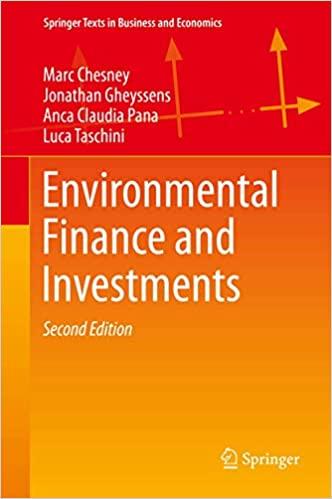Question
Homework 2 The Risk-Return Trade-off: Theory 1Question 1 Lets specialize the concept of returns we have seen generically for securities to stocks. The gross return
Homework 2
The Risk-Return Trade-off: Theory
1Question 1
Lets specialize the concept of returns we have seen generically for securities to stocks. The gross return of stock i between time t and t + 1 in state s (given available information at t) is
Ri,t:t+1(s) Ri,t+1(s) Pi,t+1(s) + Di,t+1(s) Pi,t
where
Pi,t: price at time t of stock i
Di,t+1(s): dividend paid at time t + 1 by stock i in state s
Pi,t+1(s): price of stock i at time t + 1 in state s (after the dividend is paid; ex-dividend price)
Answer the following two conceptual questions
Why Pi,t is not a function of the states of the world?
Given the definition of linear return ri,t:t+1(s) ri,t+1(s) Ri,t+1(s) 1, if we define capital gain/loss as CGi,t+1(s) = Pi,t+1(s)Pi,t Pi,t what is the implied definition of dividend yield
DYi,t+1(s)?
Suppose ABC stock price is currently $100. Assume that the (ex-dividend) stock price will either be $105 or $90 next month. (The state will be either good or bad, g or b.) Either way, the firm will pay a $5 dividend.
Compute the stock capital gain/loss, CGABC,t+1(s), dividend yield, DYABC,t+1(s) and linear return rABC,t+1(s) in the good and the bad state
Without computing the log return rABC,tln +1(s), do you expect it to be higher or lower than rABC,t+1(s) ? Why?
Given a risk-free rate of 0.0025 compute the excess return rABC,te +1(s) in the good and the bad state
2Question 2
Consider the following setup:
3 states of the world: p1 = Prob(s1) = 0.3,p2 = Prob(s1) = 0.5 and p3 = Prob(s1) = 0.2
Asset As price today is PA,0 = 100, in 6 months it pays for sure a dividend DA,0.5 = 2 and its ex-dividend price will be state-dependent either PA,0.5(s1) = 110,PA,0.5(s2) = 103 and PA,0.5(s3) = 90
Asset Bs price today is PB,0 = 50, in 6 months it pays for sure a dividend DB,0.5 = 3 and its ex-dividend price will be state-dependent either PB,0.5(s1) = 52,PB,0.5(s2) = 57 and PB,0.5(s3) = 35
the risk-free interest rate during this 6 months is 0.01
Compute the following
The expected returns, risk premia, volatilities and correlations of the three assets
The expected return and volatility of a portfolio invested 60% (i.e. with a weight of 0.6) in asset A, 30% in asset B and 10% in the risk-free asset
Hint: for question 2 first compute the (31) vector of expected return 0 and the (33) covariance matrix V0
3Question 3
Given generic asset 1, with expected return 1 and risk 1, and generic asset 2, with expected return 2 and risk 2, let 1,2 be the covariance between the two assets.
Derive the formulas for a generic proper portfolio p expected return and risk as a function of asset 1 weight p1
Derive the formulas for a generic long-short portfolio ls expected return and risk as a function of asset 1 weight ls1
What is the condition under which the two portfolios have the same expected value?
What is the condition under which the two portfolios have the same risk?
Are the two above conditions mutually exclusive? Why?
Given 1 = 0.16,2 = 0.12,1 = 0.2 and 2 = 0.2
if the proper portfolio has an expected return of 0.15, what is the proportion invested in asset 1?
if the long-short portfolio has an expected return of 0.15, what is the proportion invested in asset 1?
Step by Step Solution
There are 3 Steps involved in it
Step: 1

Get Instant Access to Expert-Tailored Solutions
See step-by-step solutions with expert insights and AI powered tools for academic success
Step: 2

Step: 3

Ace Your Homework with AI
Get the answers you need in no time with our AI-driven, step-by-step assistance
Get Started


